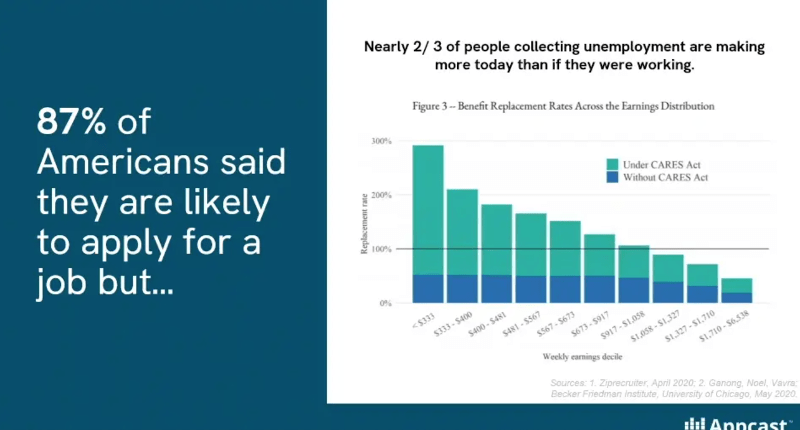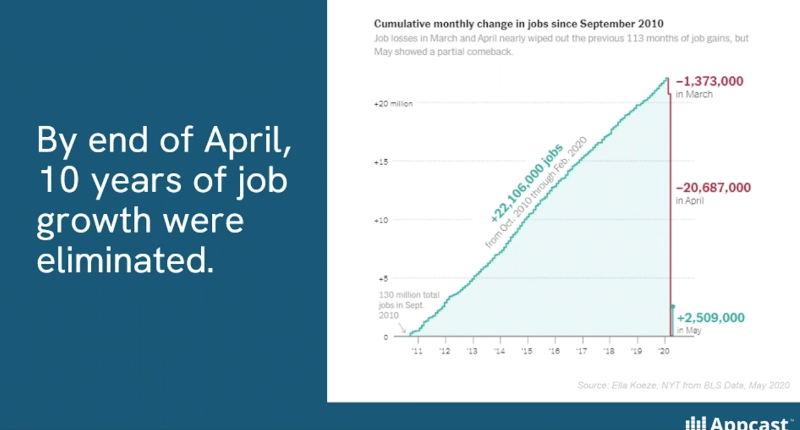The economic impact of the coronavirus pandemic on employers and candidates requires RPO providers to pivot their business. Pivoting to a new strategy often entails drastically changing an entire organization. But in the case of unexpected crisis, pivoting has more to do with quickly changing course to adapt to outside, uncontrollable forces.
Prior to the pandemic, the U.S. unemployment rate was around 3.5 percent, the lowest point in almost 50 years. By the end of April, ten years’ worth of job growth had been lost and first-time unemployment claims jumped to over 40 million. With recruitment conditions drastically changing, the business strategy needs to change in response.
In our latest RPO Leadership Forum, Leah Daniels, SVP Strategy at Appcast, presented “Recruiting Data RPO Providers Should Know.” Daniels reviewed the current state of the hiring landscape, explained why getting quality hires is still difficult, and provided tips for RPO providers to pivot their business in order to align with current conditions. Here we summarize key takeaways from Daniels’ webinar and invite you to view the full webinar for an engaging and informative presentation.
Hiring agility: How RPO helps businesses adapt to hiring disruptions
The Current State of the Hiring Landscape

It wasn’t long ago that the 3.5 percent unemployment rate meant that top candidates were employed. As a result, RPOs relied primarily on a sourcing strategy that focused on attracting candidates who are already employed, or what’s known as passive candidates. When the unemployment rate suddenly jumped to 16 percent with the coronavirus pandemic, many businesses shifted back to sourcing through job boards and targeted active candidates who are seeking work.
Where do things stand today? With an emphasis on “as of this week,” Daniels says the landscape is changing really fast. By the end of April of this year, the U.S. economy experienced a precipitous decline in job growth and a spike in unemployment. “We’d lost about 10 years of job growth, unemployment fell to 13.3 percent with a gain of 2.5 million jobs.” But by the first week of June, that number had been corrected, and “it turned out 41.5 million people filed first-time unemployment claims.”

It’s a “staggering number if you think about it,” says Daniels. To make the numbers even more confusing, in May more people were collecting unemployment than those who were classified as unemployed. What’s it all mean? That we don’t really know what the unemployment picture looks like. All we know is that the data is shifting and the numbers we’re first given aren’t always accurate.
Another way this current state of affairs is different from previous recessions is that job losses tended to be in big-ticket industries like car manufacturing and construction. This time, the sectors hit are not those we usually see. A staggering 7 million jobs have been lost in hospitality and 2 million in retail. In other words, this is more a recession of the hourly workforce. Of course, it’s possible it may shift yet again and we’ll move into a more traditional recession, especially as restaurants and hotels reopen.
Why Getting Quality Candidates is Still Tough
Despite the candidate pool drastically expanding due to the spike of unemployment, it is still difficult to find qualified candidates primarily because most active candidates don’t have the skills required for open jobs. In other words, we’re still experiencing a skill shortage.
Some are calling the coronavirus pandemic a “Shecession” because women have been disproportionately affected. People aged 20-to-24, also not a traditional target group, represent the largest percentage of the unemployed ages 20 to 55 and over.
The data also suggests that fewer people are looking for work because, thanks to the CARES Act, an amazing two-thirds of them have been making more on unemployment than they’d be if they were working. Some researchers estimate the average unemployed person is making nearly 200 percent of their previous income by collecting unemployment benefits.
For recruiters looking for someone with 10 years or more of experience, the news is much like it’s always been: they’re not the ones who are unemployed right now. The good news is the data shows those people are starting to look again. Tracking shows that clicks and applies are on the rise.
Still, while we’re seeing a bit of recovery in job seekers, the numbers aren’t significant.
One other dramatic change is in mobile usage by people searching for jobs. The number of applies via mobile show that seekers are more serious now about making a move. Daniels suggests that to capitalize on this, RPOs should be thinking about checking their clients’ mobile application process to make sure the device experience is as easy, quick, and enjoyable as possible.
The Illusion of “Quality”
Daniels argues that “quality has different meanings to different people.” Job boards see quality as a good match. Candidates define quality as aspirational. Hiring managers see it as a moving target. You probably feel it’s an impossible feat! “The bottom line is that quality means whatever your client says it means,” Daniels explained. To that end, she advises RPOs to ask their clients to clarify their take on quality hires.
Daniels offered Appcast’s programmatic job ad distribution solution as a way to optimize recruitment to:
- get more candidates while shifting your budget to the jobs that need them most,
- attract quality talent with advanced algorithmic targeting, and
- advertise effortlessly using real-time market data.
Tips to Pivot Your Recruiting Process
According to Daniels, the best thing RPOs can do to align with shifting market conditions is to stay adaptive and agile. “You need a strategy that sets you up for short-term flexibility and long-term stability,” she says. And while there are things you can’t control, there are steps you can take, including using data to meet goals.
Agile recruiting is the process of using data and technology for strategic planning and decision-making in a better, faster way. It allows you to plan for flexible contingencies, use technology for automation, and use data and tech together for real-time decision making. But keep in mind that “whatever the data tells you today might (will) be wrong tomorrow!”

Labor market data are changing extremely fast to make accurate predictions. All you can do is respond as quickly as possible to the shifts and trends as they occur.
Data measurement is a terrific strategy for improving your clients’ recruitment processes. Daniels provides the following tips:
- Unleash data. The four metrics Daniels suggests tracking are: (1) apply rate, (2) effective cost to acquire, (3) source of quality candidates, and (4) effective cost to acquire qualified candidates rate. You can then commit to fixing things at the recruiter, team or RPO, and organizational or client levels.
- Focus on job titles. Get higher apply rates by taking steps like shortening job titles to lessen candidate annoyance, performing job title audits, and making titles and job descriptions “short and sweet” to match the terms job seekers search for (typically three words or so) on job boards.
- Broaden your search. Since gut feelings and past historical trends are not particularly helpful right now, where you’re looking for people also matters. Think about recruiting out of other geographical regions.
- Post jobs on the most popular day of the week. Late Sunday night and early Monday morning are ideal as Monday at noon is still the prime time people search for jobs. By doing so you may pay the same for the click, but seekers are more likely to convert to a candidate.
Which brings us to whether you should change your current pricing model.
“That depends,” Daniels says. While apply rate is typically the metric most people use, the RPO industry itself has wide variability. Her recommendation? Use the types of jobs to choose price points, and get your clients involved so they understand how their application process is impacting the cost.
Looking Ahead
States are slowly reopening, yet COVID-19 is on the rise in many of them. Schools aren’t fully opening so many parents can’t return to work because they don’t have access to childcare. Existing models aren’t properly informing us and we’re having to use real-time data to adjust practices. In other words, we’re living in a time of uncertainty and things are shifting and moving very quickly. But while RPOs are now facing enormous obstacles, there are bright spots.
Give the entire presentation a look: Recruiting data RPO providers should know. We think you’ll be as inspired as we were.
This article was originally published by Recruitment Process Outsourcing Association on their blog.

